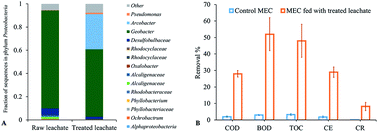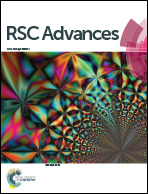Relieving the fermentation inhibition enables high electron recovery from landfill leachate in a microbial electrolysis cell†
Abstract
The energy value of the organic matter in landfill leachate can be captured with a microbial electrolysis cell (MEC), which oxidizes organic compounds at an anode and generates H2 gas at a cathode. Due to the low biodegradability of the organic matter in landfill leachate, MEC performance typically is characterized by low current density (j), coulombic efficiency (CE), coulombic recovery (CR), and organic-matter removal. Here, we evaluated whether or not Fenton oxidation of landfill leachate could enhance MEC performance compared to control MEC fed with raw leachate. Fenton pre-treatment significantly improved the leachate's biodegradability, leading to much higher MEC performance: 52 ± 10% BOD5 removal, 29 ± 3% CE, and 1.42 ± 0.27 A m−2 as j, compared to 3 ± 0.3% BOD5 removal, 1.8 ± 0.5% CE, and 0.11 ± 0.06 A m−2 as j for the raw leachate. This higher performance of the MEC fed treated leachate was associated with an ∼5-fold increase in the biofilm accumulation compared to the control MEC. Acetate-spike experiments in the control MEC revealed that inhibition of fermentation, not anode respiration, was the main factor causing poor COD removal and current density with raw leachate. The microbial community in the biofilm anode with treated leachate was enriched in anode-respiring Geobacteraceae: ∼40% of the sequences, compared to only ∼20% for MEC fed with raw leachate. Bacterioidetes, Firmicutes, Spirochaetes, and Actinobacteria were among the other abundant phyla of fermenting bacteria in the biofilm anode fed with treated leachate. This study provides proof-of-concept that Fenton oxidation of landfill leachate enhanced MEC performance by accelerating fermentation, allowing more biofilm accumulation, and establishing a syntrophic relationship between fermenters and anode-respiring bacteria (ARB).


 Please wait while we load your content...
Please wait while we load your content...